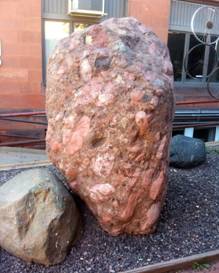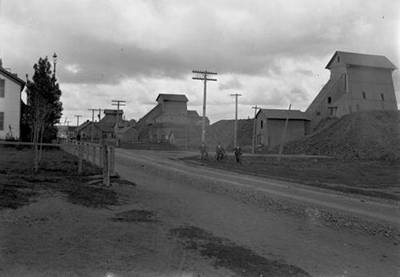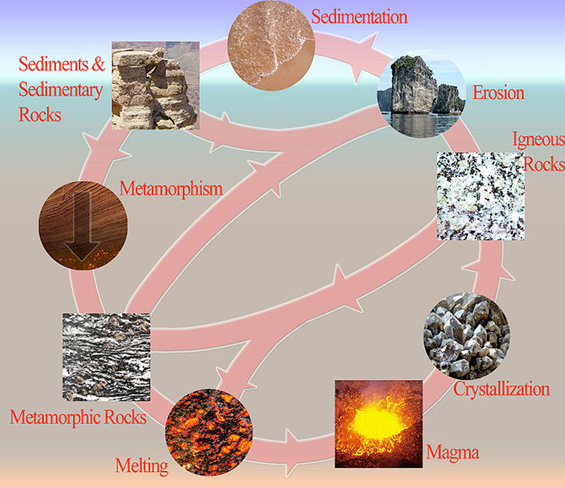Allouez Conglomerate in Houghton, MI
Cache Summary: The Allouez Conglomerate Boulder EarthCache is located in the business district of Houghton. The cache can be accessed by parking along Sheldon Street in the designated parking spaces. There is also a parking area behind the business district on East Lakeshore Drive. At the Allouez Conglomerate Boulder visitors will gain an understanding of how sedimentary rocks, like those found throughout the Keweenaw, can provide clues about past conditions on Earth.
 Figure 1. A boulder of Allouez Conglomerate in downtown Houghton. Photography by: Tim Edinger
Cache Coordinates:
Figure 1. A boulder of Allouez Conglomerate in downtown Houghton. Photography by: Tim Edinger
Cache Coordinates: N 47° 07.318 W 088° 34.164
EarthCache Lesson:
This conglomerate boulder most likely originated from the Allouez Conglomerate layer that is exposed for nearly fifty miles through the Keweenaw Peninsula. This conglomerate layer was mined for copper by three area mines: Delware, Allouez and Franklin Jr..
 Figure 2. A historical photo of 3 of the Franklin Jr. copper mineshafts, one of theAllouez Conglomerate mines in the Keweenaw. Source:http://www.miningartifacts.org/Michigan-Copper-Mines.html
Figure 2. A historical photo of 3 of the Franklin Jr. copper mineshafts, one of theAllouez Conglomerate mines in the Keweenaw. Source:http://www.miningartifacts.org/Michigan-Copper-Mines.html
This boulder was found in Houghton, moved by glaciers from its original location. It is a glacial erratic that was broken from the bedrock by glaciers as they advanced from the north. Later it was deposited in Houghton when the Glacier melted, around 10,000 years ago. If you came to Houghton in the 1850s you would have found conglomerate boulders like this scattered on the surface. This boulder was brought across town to its present location in August of 2011.
Conglomerate Rock Formation
This boulder is a type of sedimentary rock called a conglomerate. Though conglomerate rocks come in many different colors and styles, they all are made from pieces of older rocks and minerals.
Conglomerates are formed through four steps - weathering, transportation, deposition and lithification. By studying the makeup of this boulder, we can determine some of the conditions present during its formation. Weathering: The Earth’s surface goes through physical and chemical weathering processes that cause rock to break down into smaller pieces. Physical weathering includes gravity (causing rocks to fall and break into smaller pieces), abrasion by wind or water, freezing of water causing fractures, and even roots of plants causing cracks in the rocks as they grow. Chemical weathering includes dissolving of rocks and minerals. Observe the different bits of rock and mineral that makes up this conglomerate boulder. How many different types of older rock are there?
Transportation: The particles from weathered rocks move downhill with the aid of gravity, wind and water energy. Oceans, rivers, winds and even rain runoff can carry particles of eroding rocks. High energy water can move large boulders and low energy; slow moving streams can only move very fine material such as sand and silt. We can tell the type and energy of transportation by examining the shape and size of the bits of weathered rock within a conglomerate. The rocks inside this boulder are well rounded, providing evidence that they were transported by ancient streams or rivers. What do the sizes of the material tell us?
Deposition: Finally sediments are deposited, or released, when there isn’t enough energy. When the energy transporting the material loses the strength to carry these particles they drop out in the process of deposition. Normally the material is deposited into flat, horizontal layers. Do you see any layers within this boulder?
Compaction & Lithification: As more and more sediments accumulate (sometimes as great as 10 km), the added pressure causes compaction of the buried sediment particles, reducing the space between the particles.
With burial the temperature and pressure increase. Water carrying dissolved chemicals can produce changes in the sediment. This cements the sediment together creating sedimentary rocks.
Logging Your Visit:
To obtain credit for visiting this EarthCache, please email me the responses to the following question:
Logging Question 1: Describe the boulder. Include the color, size and shape of stones. Do you think it was formed in a low or high-energy environment? Explain your reasoning.
The Rock Cycle

Figure 4. Diagram of the Rock Cycle. Image: Public Domain: ZeWrestler
Logging Question 2: Describe where this boulder falls in the rock cycle and explain, using the rock cycle, how it might have came to existence.
Michigan State Science Content Expectations Addressed:
- E.SE.M.4 Rock Formation- Rocks and rock formations bear evidence of the minerals, materials, temperature/pressure conditions, and forces that created them. E.SE.06.41
Earth Science Literacy Principles Big Ideas: Big Idea 4. Earth is continuously changing. 4.6 Earth materials take many different forms as they cycle through the geosphere. This lesson shows that rocks are consistently changing, and in particular, shows how sedimentary rocks (Allouez Conglomerate Boulder) can be formed.
Common Earth Science Misconceptions:
All rocks are the same.
It’s hard to tell how rocks originated.
By visiting the Allouez Conglomerate Boulder the common misconception that all rocks are the same will be challenged. While visitors are describing the size, shape, and color of the rocks in the boulder they will find that there are different rocks that make up this one boulder. They will see that all those rocks are cemented together to form a conglomerate boulder, which will lead them to discover that not all rocks are the same. Also, if they try to identify where this rock fits in the rock cycle they will learn about the three types of rocks in the rock cycle. They will also find that sedimentary rocks like this boulder can contain igneous and metamorphic rocks.
Furthermore, the misconception that it’s hard to tell how rocks originated will start to unravel. Visitors will realize that in order for this conglomerate to form that sediments from other rocks needed to get transported to the same spot and then cemented together overtime. This will let them conclude that the rocks that made the conglomerate must be older rocks because they would have needed to be weathered, eroded and deposited before they could have cemented together to form this conglomerate boulder. Looking at the rock cycle will also bring light to the idea that not all rocks originated the same way, or even at the same time.
References:
Geology.com (2012).
Conglomerate. Retrieved from http://geology.com/rocks/conglomerate.shtml
Michigan Department of Education. (2009).
Sixth grade science grade level content expectations. Retrieved from http://michigan.gov/mde/0,1607,7-140-28753_38684_28760_49215---,00.html
Nelson, S. A. (2003).
Sedimentary rocks. Retrieved from http://www.tulane.edu/~sanelson/geol111/sedrx.htm
Rose, B (2012).
Allouez conglomerate. Retrieved from http://www.geo.mtu.edu/~raman/SilverI/HoughtonEC/Allouez_Congl.html
Schaetzl, R., Darden, J., Brandt D. (2009).
Michigan Geography and Geology. New York: Custom Publishing.